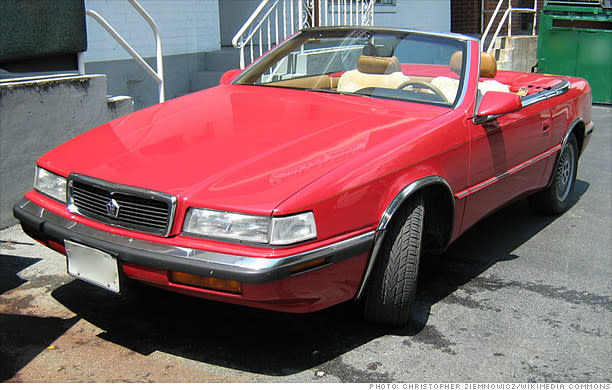10 tarnished halo cars
MORE FROM CNNMONEY.COM
In the current issue of Automotive News, Ford executive Mark Fields is asked whether Lincoln needs a "halo car." He smartly ducks the question: "We want to make sure every vehicle we bring out with Lincoln is a halo car."
Many automotive terms have become anachronistic or simply defunct over the years -- rumble seat, four-on-the floor, carburetor -- but for some reason, the notion of the "halo car" survives. It's a car with a stylish design or unusual features meant to draw customers into a showroom but not generate a lot of sales -- or make a lot of money.
While halo cars may look heavenly when they are conceived, as often as not they end up as fallen angels. They are dismissed as automotive curiosities that failed to capture public imagination, while creating an effect exactly opposite to the one they were designed for: damaging brands rather than lifting them. Here are some classic examples of tarnished halos:
Chrysler Crossfire 2003-2007
Conceived as a tribute to the ill-fated merger of Daimler-Benz and Chrysler, 80% of the Crossfire's parts came from Mercedes, and the car itself was assembled in Germany. But just as Chrysler itself never warmed to the Daimler takeover, customers never warmed to the Crossfire's mixed parentage, leaving huge inventories of unsold cars. After peaking at 35,700, annual sales dribbled down to 2,000 before Chrysler, in a pre-bankruptcy restructuring, ceased production.

Pontiac Solstice/Saturn Sky 2005-2009
These two roadsters were supposed to inject a much-needed jolt into the flagging Pontiac and Saturn brands, and GM launched them with all the thunder that a failing automaker could muster. Yet even the imprimatur of design guru Bob Lutz couldn't fend off harsh comments from car reviewers who found them dynamically inferior to the long-established Mazda Miata and incapable of carrying any baggage than could fit in a number 10 envelope. Touted as instant classics, they are now little more than curiosities -- poor relatives to the 60-year-old-and-still-going-strong Chevy Corvette.

Lincoln Blackwood 2002
A luxury pickup (or was it a Ford F-series with a Lincoln badge?), the Blackwood made a splash at the Detroit auto show in 1999 and figured to coast in the wake of the hugely successful Navigator. Only available in -- what else -- black over black, it featured a power-covered bed made of plastic composites and decorated with artificial burled blackwood. Alas, production problems with the bed and the lack of a compelling sales proposition (luxury pickup?) sent the Blackwood to the great garage in the sky after just 15 months of production that yielded 3,356 trucks.
Ford Thunderbird 2002-2007
After suspending production of the by-then supersized original Thunderbird in 1997, Ford revived the T-Bird in its old roadster body style five years later. But the attempt to trade on half a century's worth of nostalgia never caught the attention of middle-aged customers, and enthusiasts were turned off by the sloppy engineering. Ford let the T-bird fly the coop after a truncated five-year run.

Subaru SVX 1991-1996
A two-door GT car with avant-garde styling from the maker of sturdy and practical Outbacks and Foresters? That was the concept behind the SVX, immediately identifiable by its unusual two-piece power slide window. Representing a roughly $10,000 walkup from the next-most expensive Subaru, it gave new meaning to the term "sticker shock." The ungainly SVX found only 640 buyers during its last year on the market.

Cadillac Allante 1987-1993
Designed to restore some exclusivity and sex appeal to the Cadillac brand, the Allante was designed and built in Italy, then flown to Detroit for assembly in specially equipped 747s. But the international pedigree couldn't obscure some fundamental shortcomings. Overweight, underpowered, and overpriced, the Allante handled badly and was prone to leaking in heavy rainstorms. The car was no help to Cadillac, and General Motors lost thousands of dollars on each of the 21,430 it produced.

Buick Reatta 1988-1991
The split-personality Reatta came with an automatic transmission, whose simplicity appealed to Buick's older buyers, and a high-tech touch-screen control panel that was bound to befuddle them. But then the whole notion of a Buick roadster was oxymoronic. Sales never came close to the planned 20,000 a year, peaking at 8,515, and Buick's first two-seater in half a century was euthanized after a short run.

Chrysler TC by Maserati 1989-1991
Lee Iacocca had a lot of good ideas -- Mustang, Jeep, the minivan -- but the TC wasn't one of them. Built on a Chrysler K-Car platform and assembled in Milan, Italy, the car was introduced in 1986 but was kept from production for three years by development problems. Expensive for its time ($33,000 at introduction) and separated at birth from the thousands-less Chrysler LeBaron, the TC was supposed to sell at a rate of 5,000 to 10,000 a year but was mercifully terminated after total sales of just 7,300.

Chevrolet SSR 2003-2006
Cool! A retractable hardtop convertible pickup truck! The SSR sure had curb appeal. Too bad the execution wasn't as neat as the concept. Based on GM's midsize SUVs, the SSR weighed a ton, and even an outing as pace car for the Indy 500 couldn't camouflage its dynamic shortcomings. Pricey at $42,000, the SSR couldn't carry much either, especially when the roof was retracted. Total production before Chevy shut the lid: 24,150.

Studebaker Avanti 1962-1963
With Studebaker on the ropes, the Avanti was introduced to the public in April 1962 and rushed into production. Considered daring for its time, Studebaker planned to build 20,000 of the fiberglass-bodied Avantis in the first year, but production problems with the new material limited the output to 1,200. That wasn't nearly enough to save Studebaker, which ceased operations a year and a half later.

 Yahoo Autos
Yahoo Autos 


